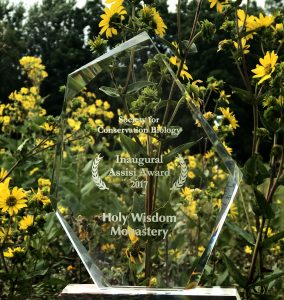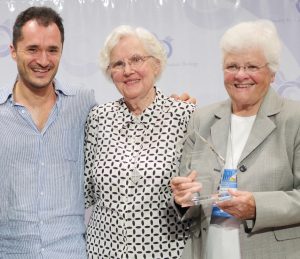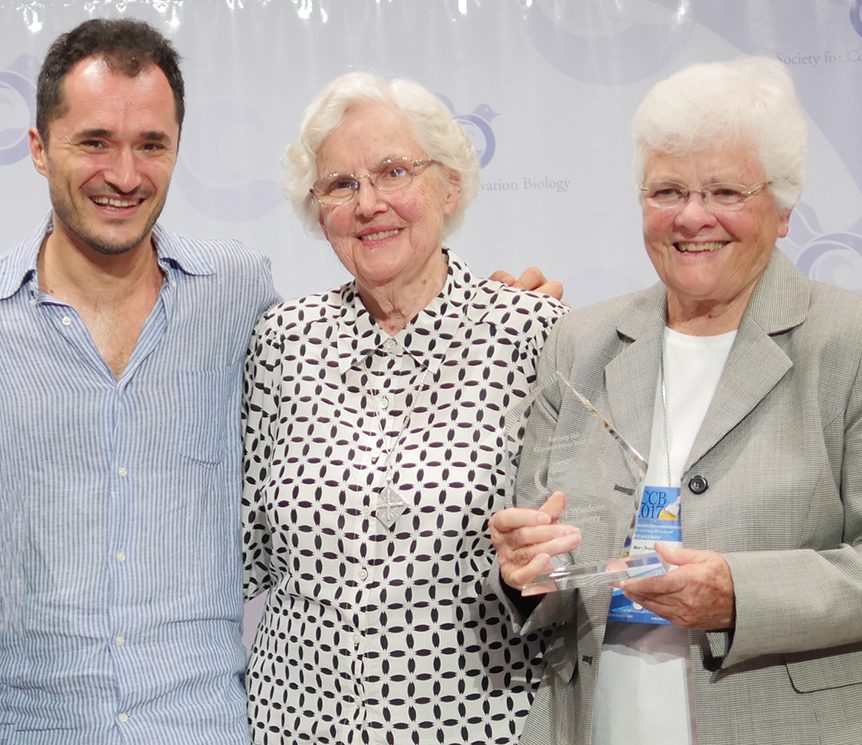
The Benedictine Sisters at Holy Wisdom Monastery received the inaugural Assisi Award for faith-based conservation at the 28th International Congress of Conservation Biology’s Opening Ceremony on July 23, 2017 in Cartagena, Colombia in front of nearly 1,500 attendees.
The Assisi Award acknowledges organizations and individuals whose work demonstrates that faith-based conservation is contributing significantly to the common global effort of conserving life on Earth.

Sisters Joanne Kollasch (center) and Mary David Walgenbach accept the Assisi Award from the Society for Conservation Biology president Fabrizio Frascaroli in Cartagena Colombia, July 2017.
Sisters Mary David Walgenbach and Joanne Kollasch accepted the award on behalf of their religious community located near Madison, Wisconsin. Their community is the first ecumenical Benedictine community in North America where Catholic and Protestant women live, pray and work together. Holy Wisdom Monastery is home to these Sisters whose mission is to weave prayer, hospitality, justice and care for the earth into a shared way of life.
Sister Mary David, Prioress of Holy Wisdom Monastery, said, “The Sisters and the women and men who support Holy Wisdom Monastery are deeply honored to receive the Assisi Award. The Sisters and Holy Wisdom Monastery inherit the 1500 year-old Benedictine tradition of caring for creation. This heritage is lived today in collaboration with environmentalists and scientists in our building the highest rated LEED (Leadership in Energy and Environmental Design) Platinum certified building in the United States. Our Wisdom Prairie Project improves the water quality of Madison lakes, streams and wetlands.”
Holy Wisdom Monastery was nominated for the Assisi Award by Jame Schaefer, Systematic Theology and Ethics Professor at Marquette University in Milwaukee, WI. Schaefer learned about the restoration efforts at Holy Wisdom Monastery, followed the progress online, visited the monastery, featured Holy Wisdom in a presentation she made at the International Congress for Conservation Biology in Montpellier, France in 2015 and worked together with Stephen Awoyemi (former president of the Religion and Conservation Biology Working Group of the Society for Conservation Biology) from 2014-2016 to propose and create an award for faith-based conservation.
“I knew I would nominate Holy Wisdom Monastery (HWM) and did,” explains Schaefer. “The nomination process was arduous, but HWM staff and professionals in state and local governments and non-governmental organizations helped considerably by providing the data needed and letters supporting my nomination. The evaluation of the nominations by experts in the bio-conservation field was intensive, and, of course, I was thoroughly delighted that HWM was chosen as the first recipient of the Assisi Award. Local endeavors like HWM’s are increasingly important and significant as support for conservation of species, ecological systems, and the biosphere sinks to the lowest level of state and national governance that I have observed during my lifetime.”
The Sisters at Holy Wisdom Monastery, along with thousands of volunteers, professionals and coworkers, have been caring for the land on the north side of Lake Mendota since arriving in 1953 to open a girls’ high school and later a retreat and conference center. They purchased 42 acres of land with a small glacial lake and hilltop view of the city of Madison and Lake Mendota. From the beginning, they fended off multiple attempts by developers to purchase portions of the monastery land.
The land had been farmed and had few trees on it. The process of returning the land to a more pre-settlement existence soon began with the gradual elimination of farming and the planting of trees and bushes to attract native wildlife. Several years later they acquired an additional 96 acres.
In the early 1970s, conservation practices included the contouring and planting of grass waterways in the areas still being farmed, following a plan by the Dane County Soil Conservation Service. With the 1980s came the conversion of highly erodible hillsides to woodland and savanna areas, using the government Conservation Reserve Program.
The first comprehensive master plan for the monastery grounds was completed in June 1995. It consisted of the elimination of farming lands and restoration of all possible acres to native prairie and wetlands.
In July of 1996, the prairie and wetland restoration plan was approved as one of two demonstration projects of the Lake Mendota Priority Watershed. Dane County Agricultural Extension staff provided many hours of engineering expertise toward the plans to recover silted-in Lost Lake and convert 60 acres of agricultural land into wetland and prairie.
Holy Wisdom Monastery worked with the Dane County Natural Heritage Foundation, Madison Audubon Society, the Village of Marshall, the Wisconsin Department of Natural Resources and Prairie Enthusiasts to form the Environmental Internship Coalition of South-Central Wisconsin in 1998. Each summer, for the next 10 years, the coalition provided college students with a hands-on experience in managing environmental restoration projects at the monastery and other environmental sites in Dane County.
In June 2008 at the beginning of the new monastery building project, HoChunk elder Tom Hopinka blessed the land and called it “sacred.” After years of planning the Sisters were ready to have Hoffman Planning, Design & Construction, Inc. of Appleton, Wisconsin construct an environmentally responsible building on the site.
The U.S. Green Building Council awarded Holy Wisdom Monastery a Platinum rating—the highest level of Leadership in Energy and Environmental Design (LEED®) certification available in March 2010. The monastery earned 63 out of a possible 69 points under LEED-New Construction version 2.2, making it the highest-rated LEED building in the United States to date.
99.75% of the old building was recycled. The new building’s eco-friendly features include geothermal heating and cooling, solar panels to generate 8% of the energy needs and solar light fixtures in the parking lot, low flow fixtures, sky lights, tinted and operable windows, solar tubes, instant hot water heaters, pervious concrete in the low areas of the parking lot, living ‘green’ roofs that are highly reflective and rain barrels.
In September 2012, with the help of donors, the Sisters purchased 53 acres of farmland adjacent to the monastery grounds to protect the north slope of Lake Mendota from urban development. This completed a ‘green necklace’ of land surrounding the edge of Lake Mendota.
The Friends of Wisdom Prairie, a newly created environmental support group, kicked off with a dinner lecture featuring a Conservation Biologist from the Wisconsin Department of Natural Resources in September 2014. Since the beginning, the Friends have offered events and tours to educate people on caring for the earth.
In October 2014 Holy Wisdom Monastery became Madison Gas and Electric’s largest solar customer by adding additional photovoltaic panels that generate 60% of the monastery building’s energy needs. The goal is to eventually generate 100% of the energy needs. In November of 2014, the Sisters signed an easement with Dane County for a bike trail along County Road M.
Current projects include planting an oak savanna, educational programming and workdays for the public, maintaining almost 130 acres of prairie and developing a new master plan for the next 10 years.
The Assisi Award recognizes conservation initiatives around the world led by faith leaders from world religions and indigenous peoples. Fabrizio Frascaroli, president of The Religion and Conservation Biology Working Group of the Society for Conservation Biology, said, “We hope the award will highlight how the drive to protect the biosphere is not the prerogative of a single philosophy, but rather stems from a variety of worldviews, values and knowledge systems.”
The name of the Assisi Award celebrates a historic 1986 meeting where leaders of all major world religions made public declarations to protect the environment. The meeting was an initiative of His Royal Highness The Duke of Edinburgh, President of World Wildlife Fund International at the time.
The town of Assisi was chosen as the meeting site due to its connection to St. Francis, a saint ecumenically admired and also respected by non-Christians in virtue of his reverence for nature and close bond with the natural world.
Brooke Weiland, president of the Wisconsin Society for Conservation Biology who attended the conference said, “Holy Wisdom Monastery is setting an example of the natural fit between faith and conservation—not only working to protect valuable prairie habitat but also fostering a sense of place among the community.”
“For us, sustainability is not a trend,” says Sister Joanne, “but a commitment to the earth—a 21st century expression of 1500 years of Benedictine tradition.” Adds Sister Mary David, “It’s not the thing to do; it’s the right thing to do.”
* * *
Read the press release issued by The Society for Conservation Biology
Download print version of the Holy Wisdom Monastery press release



Comments 2
I read the article, chronicling the wonderfully peaceful and quietly unfolding decade’s story of Holy Wisdom Monastery, with tears of gratitude in my eyes. I have been richly blessed to have been able to follow the life and love of these courageous Benedictine women for almost 45 years, having first discovered “St. Benedict’s Center” in the 1970’s. Through all of its nominal and phenomenal permutations over the decades, I have watched and experienced the graceful and grace filled evolution of not only a vibrant community of pioneering women but also the resulting salvation they have afforded every conceivable form of being in every nook and cranny of God’s vibrant creation that had the good fortune to have been located anywhere within the scope of their blessed radar. (Go ahead, read that run on sentence again.) Holy Wisdom Monastery is truly a unique piece of sacred ground and every person who can possibly find their way to visit this holy place and these holy people should most definitely do so, you will be changed forever, you will be filled with the grace of their Benedictine PAX. With great love, Dennis Crowley
Dear Dennis,
It was a joy to read your congrats on our Assisi Award for faith-based organizations. It was a great honor for Holy Wisdom and all the women and men who support us with their work, prayers and funds.
I hope you will come and visit us again. A walk in the prairie is a spiritual joy.